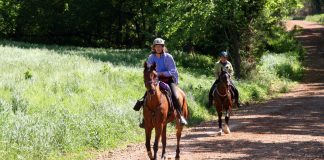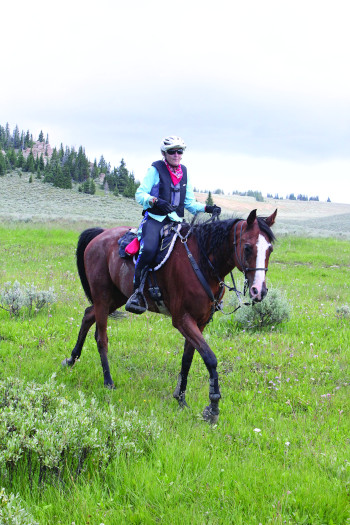
Not many people would consider climbing aboard a horse soon after breaking ribs. But not everybody is Suzanne Hayes, who won the Big Horn 100 endurance ride just six weeks after a fall that resulted in 10 broken ribs (some in multiple places), two fractured vertebrae, a punctured lung and a lacerated liver, and that led to her spending five days in the ICU and 10 more days in the hospital.
“I told them, ‘Well, I’ve got a really big 100-mile ride in six weeks,’” Hayes recalls. “‘I’m hoping that we can still plan on that.’ They looked at me like, ‘You gotta be kidding me.’”
Her accident happened while riding a young horse on a routine training ride. The horse stopped in a creek a quarter-mile from home to drink when he suddenly bolted, violently ejecting Hayes. (Hayes and her husband later determined he’d received an electric shock on his sensitive nose from a live fence wire that had fallen into the creek nearby.)
Compromised!
The Big Horn is one of the last old-fashioned 100-mile races.
“It’s a really difficult 100, and it takes a lot of perseverance to get through it,” says Hayes. “You have to pay attention because it’s so remote. I just really like tough rides.”
Riding the Big Horn 100 in such a compromised state didn’t seem like a far-fetched idea to this experienced high-mileage endurance rider. So many factors went into forging ahead with the plan that it appeared the obvious choice, the way Hayes explains it.
Early in 2020, Hayes had offered her horse, Greenbriar Al Jabal (“Atlas”), to fellow endurance rider Ann Hall to ride along with Hayes on Sanstormm.
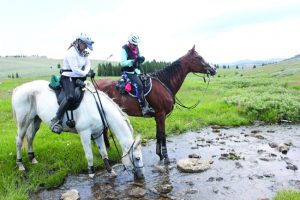
“Atlas was three for three [in the top five] in the Big Horn [with a win in 2012], and Sans was zero for two,” says Hayes. “I thought this might be a really good opportunity for Ann to come up and ride Atlas with me on Sans. And that would be really good for Sans, because he would learn a lot from Atlas.”
Hall was excited to do it; she and her husband had planned a big two-week adventure. Hayes didn’t want to let her down. While her decision might seem irrational, she is anything but.
“I carefully weighed it out,” says Hayes. “I thought, how many times have I ridden a horse, how many times have I come off a horse, and what was the percentage. And I just felt like the percentage was low enough that I would do the ride.”
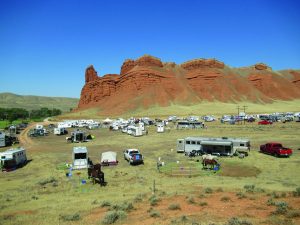
From 9 Miles to 100
Hayes didn’t get authorized by her doctors to ride until a week before the Big Horn, and technically didn’t get an OK at all.
“I got a CT scan the week before the ride,” she says. “I’d hoped they’d look at it and say, ‘You’ve healed up really well. We don’t have any problem at all if you ride at Big Horn.’ But they didn’t. They said that my injuries at six weeks were where they should be: my ribs were still separated, and they were worried about my liver, because it takes three months to heal. They said, ‘We can’t tell you that you should ride. We would recommend that you don’t. You really shouldn’t. There’s a risk involved. But it’s your choice.’”
Her final test was a training ride on Sans the week before the Big Horn, trotting and cantering for 9 miles.
“There was a fair amount of pain, but it was tolerable,” says Hayes. “Later on that night, it was a little worse. But I thought, well, I’ve got one more whole week to heal. Week five, I felt there was fairly significant improvement, so I thought that extra week six was going to be even better.”
The Big Horn would be “just” 91 more miles of riding; how hard could it be?
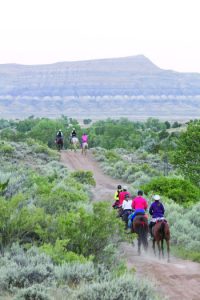
With Deference
Hayes loaded up and pointed her trailer south for Shell, Wyo., basecamp for the August 1st Big Horn.
She took extra precautions during the ride, wearing both a chest protector vest and an inflatable crash vest, should she unexpectedly part from her saddle. She also rode with a Garmin SPOT.
“I had my own SOS basically, because if I activated that SPOT, it automatically went to 911,” she says. “And Ann was riding with me, which was another reason I felt better.”
Hall opened all the gates (there are some 38 gates on the ride), since it was most difficult for Hayes to mount and dismount.
Compared to the prior weeks of drama, the Big Horn ride itself went smoothly. Exhibiting the smarts and patience befitting a rider who has already garnered an American Endurance Ride Conference Pard’ners Award with her previous endurance horse, Kootenai Zizzero, Hayes and Hall strategically stayed in the lead or within stalking distance throughout the ride.
Leaving the last vet check 16 miles from the finish, Hayes felt she had a solid chance to win, but was held back by her impaired condition.
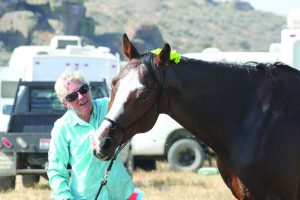
“I had a ton of horse,” Hayes says. “But I couldn’t do anything about it, because I couldn’t ride by myself. When Gabriela Blakeley left our group [to go ahead], I couldn’t go with her, because I couldn’t say, ‘Gabriela, you have to wait and open these gates for me.’”
After the last gate 3 miles from the finish, Hayes turned Sans loose. Texas rider Cameron Holzer kept pace with her, and with extraordinary riding etiquette refused to pass, since Hayes had been ahead of her most of the ride. Those two crossed the finish line in second and third place, in a ride time of 15 hours and 15 minutes.
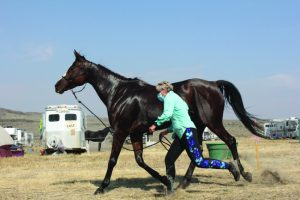
Tough as Nails
It wasn’t till morning that Hayes learned that Blakeley’s horse, first across the finish line, had not pulsed down in the requisite 30-minute window. That left Hayes the surprised winner of the 2020 Big Horn 100.
Anyone who knows Hayes well always incorporates the word “tough” when describing her.
She took nothing stronger than Tylenol and Aleve during the ride. Elatedly walking up to receive her award at the morning’s ceremony, she gave no indication she’d won one of the country’s hardest rides while mending multiple broken bones.
Hayes credits her friends Tara Rothwell and Lynn Lee for keeping her horses in shape while she was incapacitated. Lee also accompanied Hayes to the ride and crewed for her, as she often does.
While Suzanne Hayes raised the bar awfully high for the majority of endurance riders, Lee, who’s been friends with Hayes for 48 years, is not so surprised at the exploit in the Big Horn 100.
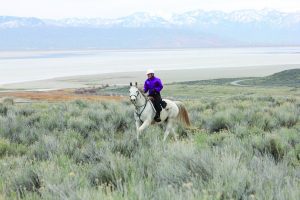
“You’ve got to know Suzie,” Lee says. “I’ve known her forever. And she comes from tough stock. Her dad and brothers were ultra-marathoners, and her mother started in endurance when she was a teenager in Vermont. So it’s in Suzie’s blood. And when she gets it in her head to do something, she does it.
“But she’s way tougher than I am!”
This article about Suzanne Hayes winning the Big Horn 100 appeared in the April 2021 issue of Horse Illustrated magazine. Click here to subscribe!




